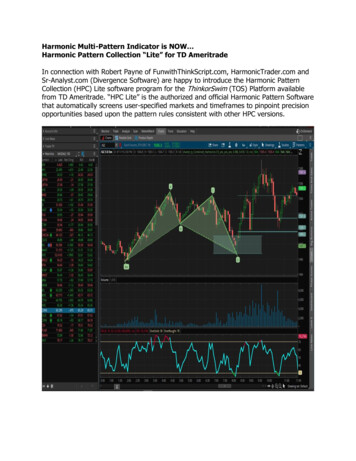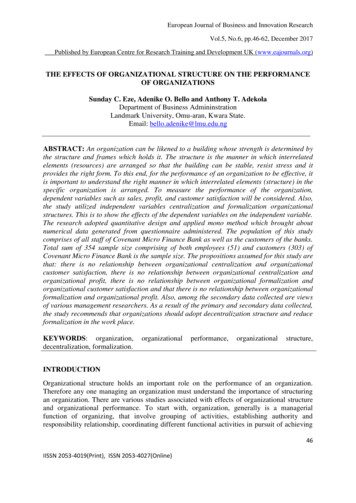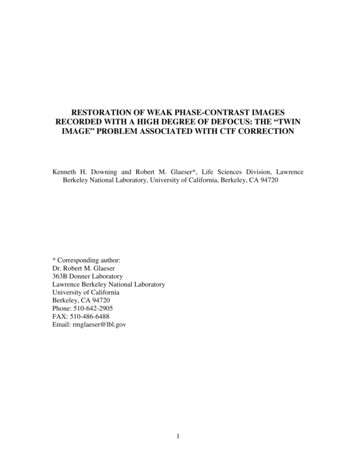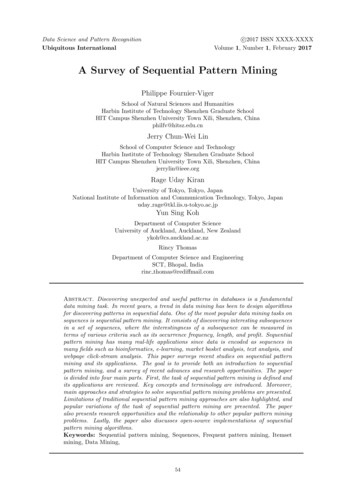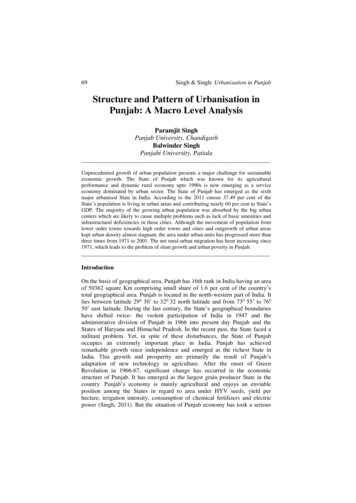
Transcription
69Singh & Singh: Urbanisation in PunjabStructure and Pattern of Urbanisation inPunjab: A Macro Level AnalysisParamjit SinghPanjab University, ChandigarhBalwinder SinghPunjabi University, PatialaUnprecedented growth of urban population presents a major challenge for sustainableeconomic growth. The State of Punjab which was known for its agriculturalperformance and dynamic rural economy upto 1990s is now emerging as a serviceeconomy dominated by urban sector. The State of Punjab has emerged as the sixthmajor urbanised State in India. According to the 2011 census 37.49 per cent of theState’s population is living in urban areas and contributing nearly 60 per cent to State’sGDP. The majority of the growing urban population was absorbed by the big urbancenters which are likely to cause multiple problems such as lack of basic amenities andinfrastructural deficiencies in these cities. Although the movement of population fromlower order towns towards high order towns and cities and outgrowth of urban areaskept urban density almost stagnant, the area under urban units has progressed more thanthree times from 1971 to 2001. The net rural-urban migration has been increasing since1971, which leads to the problem of slum growth and urban poverty in Punjab.IntroductionOn the basis of geographical area, Punjab has 16th rank in India having an areaof 50362 square Km comprising small share of 1.6 per cent of the country’stotal geographical area. Punjab is located in the north-western part of India. Itlies between latitude 290 30’ to 320 32 north latitude and from 730 55’ to 76050’ east latitude. During the last century, the State’s geographical boundarieshave shifted twice- the violent participation of India in 1947 and theadministrative division of Punjab in 1966 into present day Punjab and theStates of Haryana and Himachal Pradesh. In the recent past, the State faced amilitant problem. Yet, in spite of these disturbances, the State of Punjaboccupies an extremely important place in India. Punjab has achievedremarkable growth since independence and emerged as the richest State inIndia. This growth and prosperity are primarily the result of Punjab’sadaptation of new technology in agriculture. After the onset of GreenRevolution in 1966-67, significant change has occurred in the economicstructure of Punjab. It has emerged as the largest grain producer State in thecountry. Punjab’s economy is mainly agricultural and enjoys an enviableposition among the States in regard to area under HYV seeds, yield perhectare, irrigation intensity, consumption of chemical fertilizers and electricpower (Singh, 2011). But the situation of Punjab economy has took a serious
JPS 21:170turn with the introduction of liberalisation and globalisation policies during theearly 1990s. The growth rate of Punjab economy remained consistently (except1996-97) lower than of India as a whole. In terms of growth rate of gross statedomestic product, out of 28 states of Indian Union, Punjab was at the 27 thposition during the 10th five year plan, whereas during the 11th plan, thesituation became worse and Punjab has recorded the lowest growth rate inIndia. This has happened due to the lower growth of agriculture sector (Singh,2011; Planning Commission, 2007).Urbanisation and agricultural development are closely linked in Punjab.Agricultural prosperity has caused the shift of population from rural areas tothe urban economy. Punjab has a long urban history from the Harappacivilization. During the colonial rule, the urbanisation process in Punjab wasmainly driven according to the interest of Colonial ruler. With theestablishment of British rule and introduction of the railway the physicalorganization of towns and cities in Punjab recorded remarkable transition. Theexpansion of railway network caused the spatial outgrowth of existingtowns/cities towards the railway station (Grewal, 1997; Grewal and Grewal,2005). In Punjab, during the British rule, there was development of Manditowns near the railway stations to export the raw material through rail networktowards the major Indian ports and from these ports to the British Empire. Sothe urban structure of Punjab, inherited from the colonial period, wasnevertheless relatively balanced as compared to other Indian States.The agriculturally prosperous State of Punjab showed a marked increase inits urban population since independence. The population of urban areas inPunjab increased very sharply after 1970s. At the dawn of the twentiethcentury, only 12.46 per cent of the total population of the then pre-partitionPunjab was urban. At the beginning of the twenty-first century, the urbanpopulation of Punjab has increased to 33.95 per cent, against 27.78 per cent forthe country as a whole. According to the 2011 census, 37.49 per cent of theState’s population is living in urban areas and contributing nearly 60 per centto State’s GDP but urban development got only 2 to 3 per cent of total outlaysof plans. It is evident that the growth rate of urban population has been fairlyhigh in Punjab. In fact, the State has always been among the high urbanisedStates in India. Punjab is now the sixth major urbanised State in India afterKerala, Tamil Nadu, Maharashtra, Gujarat and Karnataka.The present work is an attempt to analyse the spatial as well as temporalpatterns of urbanisation in Punjab. It is based on the analysis of urbanisationand other related aspects from 1971 to 2001. However, the provisional data ofrural-urban distribution of population for the 2011 census are now alsoavailable. The analysis also covers the changes which have happened duringrecent times. The logic behind the selection of above time period was mainlyfor three reasons as below:1. The period from 1971 to 1981 presents the major change in Punjabagriculture known as Green Revolution which gave a boost to agro-processingactivities in particular and industrial development in general. So it becomes
71Singh & Singh: Urbanisation in Punjabessential to analyse the pace and pattern of urbanisation during this period andits relation with agricultural and industrial development.2. During 1981 to 1991 Punjab faced socio-political disturbances. During thisperiod, terrorism has affected the rural as well as urban areas of Punjab. It isquite important to look into changes in population distribution during thisperiod.3. The period from 1991 onwards is referred as the period of globalisation andliberlisation. Due to the shift in economic policies, many significant socioeconomic changes have occurred. The western vision of life has made an effecton the psychology of Punjabies. This period is referred to as the period ofmodernisation in the sense that the development of communication as well astransportation facilities has aided a pace to the urbanisation process.Degree of UrbanisationUrbanisation has often been regarded as a positive manifestation of economicdevelopment. It is being argued that without urbanisation economic and socialdevelopment may be slow. From the last century and a half there has been amassive growth in urban population. The process started in Europe and wastaken up in other parts of northern hemisphere; nowadays, the most impressiveurbanisation process is taking place in developing countries (Berg et. al.,1982). By the end of 18th century, people who lived in the towns and citieswere estimated to be about 3 per cent of the world population, but in 2008 theproportion of the population living in urban areas reached to 50 per cent(Bhattacharya, 2002). In the developed countries of the modern days,urbanisation is very much related to industrialisation. The case is not the samefor developing countries. In most of the developing countries, it is not theindustrial pull which attracts the population towards urban centers. In case ofdeveloping countries rural overpopulation is the major push factor compellingthe urbanisation process. In these countries, the rate of industrialisation andmodernisation has failed to keep pace with urbanisation. The higher proportionof population of underdeveloped world suddenly moves towards cities beyondthe capacity of latter. The consequences of this may be urban poverty, ratherthan industrialisation and modernisation (Smiles, 1975). As far as India isconcerned, due to two centuries of colonial rule, the urban structure of Indiahas not been following the pattern of urbanisation which is based on theagricultural development and strong urban industrial base as experienced bymost of the developed counties during their urban transition. Indianurbanisation model is basically a colonial urban model. The imperialist hasdeveloped the cities and towns to facilitate the transportation of raw materialand surpluses from the Indian periphery to developed imperialist centers andimport the finished products through the same route to sell in the market ofrural hinterland of periphery.In Punjab, the process of urbanisation has been a steady process for a longtime, but during the last few decades it has gained extra momentum. This wasthe period of accelerated agricultural growth, followed by industrilisation of
JPS 21:172the State. During the last 50 years, urban population in the State has increasedfour times whereas the population of the State has increased only two and halftimes. With the advent of the green revolution and labour saving technology inthe agriculture, the population in rural localities of Punjab is continuouslydecreasing.During 1971, out of the total population 76.27 per cent was living in therural areas and since then the proportion of rural population was decreased andit has reached to 62.51 per cent in 2011. On the other hand, the urbanpopulation in Punjab is showing an upward movement. The urban populationin Punjab was 3.22 million (23.73 per cent of the total population) in 1971 andit has increased to 37.49 per cent in 2001 (Vide Table and Figure 1).Table 1: Rural and Urban Population in PunjabYearRuralPopulation(in million)UrbanPopulation(in million)TotalPopulation(in million)13.55RuralPopulationasPercentageof TotalPopulation76.27UrbanPopulationasPercentageof e: Census of India, 1971 to 2001, Punjab, Series-4, Final PopulationTotals and Provisional Population Totals, 2011 Census.Figure 1: Distribution of Rural and Urban Population in .5527.6837.4933.92Urban population as Percentageof Total Population20100197119811991Source: As in Table 1Rural Population as Percentageof Total Populaton20012011
73Singh & Singh: Urbanisation in PunjabTable 2: Decadal and Compound Annual Growth Rate of UrbanPopulation in PunjabPercentage Decadal dGrowth 25.213.22001-1113.7325.767.5818.202.3Source: Census of India, Punjab, 1971 to 2001, Series 2, ProvisionalPopulation Total of 2011.The decadal and annual compound growth of population is highlighted inTable 2 above. The decadal growth of the total and the rural population hasdecreased during the period from 1971 to 2011. The urban population showeda very impressive decadal growth during 1971-81. It has 44.51 per cent whichwas significantly higher in comparison to the growth rate of total and ruralpopulation during this period. There have mainly three reasons which wereresponsible for this impressive growth. Firstly, due to the advent of greenrevolution the income of farming households increased and they movedtowards the urban localities for better facilities and opportunities. During theperiod from 1970-71 to 1980-81, Punjab has recorded historical increase in percapital income. During 1970-71 the per capita income at constant prices inPunjab was Rs. 1070 whereas the per capita income at the national level wasrecorded only Rs. 633. After the period of ten years (during 1980-81) the percapital income of Punjab has reached to Rs. 1354, which was near aboutdouble as compare to per capita income at national level (Government ofPunjab, 1985). This was primarily occurs due to the agricultural revolution inPunjab. Secondly, a large number of people moved due to the push factor asthe mechanisation of agriculture reduced the requirement of labour foragriculture. Thirdly, the development of the industrial corridor along theLudhiana, Jalandhar and Amritsar highways led to the movement of populationfrom the surrounding areas to the towns. The decadal growth rate of urban
JPS 21:174population has decreased from 44.51 per cent to 29.11 per cent in the nextdecade but it was still higher than the growth of rural and total population.The decade of 1981-91 has been described as the lost decade or a decade ofmissed opportunities for Punjab (Shivramakrishnana, et. al., 2005). During thisperiod, to a large extent, Punjab suffered due to the disturbed socio-politicalconditions and widespread terrorism. In the next decade (1991-2001), whichwas also known as the period of globalisation, the decadal growth of urbanpopulation again accelerated in Punjab and it has reached to 37.86 per cent. Itwas near about three times higher than the growth of population in ruralPunjab. It was the time when people started looking for better employment andeducation opportunities and better possibilities for investment. The higherincome group of rural localities moved towards urban areas for bettereducation and better investment opportunities. The lower income group fromrural areas moved in the hope of finding better employment opportunities toraise their standard of living. During this decade, the growth of the servicesector in Punjab is higher in comparison to the secondary and primary sector.It is also known as the period of tertiarisation of Punjab economy (Singh,2010).The provisional population results of the 2011 census reveal that thedecadal growth of total, urban and rural, population has recorded a decline ascompared to the previous decade. During this period, the growth of urbanpopulation has reached 25.76 per cent which is nearly twice that of the overallpopulation growth rate (13.73 per cent) and more than three times that of therural population (7.58 percent) growth rate. The annual compound growth ofurban population was highest (3.7 per cent) during 1971 to 1981. In the nextdecade, the per annum compound growth of urban population decreased to 2.6per cent but in 1991-2001, the growth of urban population again acceleratedand reached 3.2 per cent per annum. The recent data reveal that the annualcompound growth of urban population is 2.3 per cent from 2001 to 2011 whichis lowest as compared to all the previous decades.Generally to examine the urbanisation process in a particular region theresearchers are concerned only with the percentage of urban population to thetotal population (U/ U R) (Bose, 1973). There is a problem of underestimationin this measure because a segment of urban population, that consists of largelyof the refugees from the rural areas who have not been integrated with theurban economy would figure in the denominator (Kundu, 1980).Table 3: Degree of Urbanisation in PunjabYear1971Urban Population as Percentage of RuralPopulation (U/R)31.12198138.22199141.94
75Singh & Singh: Urbanisation in Punjab200151.33201159.47Source: Census of India, Punjab, 1971 to 2001, Series-4, Final populationTotals and Provisional Population Totals 2011.For the correct estimation of the degree of urbanisation in a region and toremove the defects of the underestimation, Kundu’s Method the percentage ofurban population of the rural population (U/R) has been chosen in the presentanalysis. During 1971, the percentage of urban population to the ruralpopulation was recorded 31.12 per cent. Since then it has continuouslyprogressed and reached to 59.47 per cent in 2011. It means that the percentageof urban population was more than the half of the rural population in Punjab.Number of Urban UnitsOne of the most persistent generalisations concerning the urban transformationin the developed countries is the assertion that it rested upon a series oftechnological as well as productive changes which led to growth of industrialand agricultural production. These changes led to a change in occupationalcomposition of the population of these countries from agriculture to nonagricultural activities and increasing concentration of people in urban places(Mc Gee., 1983). The increase in the number of urban units is a sign ofmodernisation and commercialisation of economic activities. As long as thenumbers of urban units increase it is a sign of development because people aremoving towards better inhabitant and better socio-economic environment.Table 4: Class-wise Distribution of Towns and Change in Number ofTownsCategoryof TownsNumber of TownsChange in Number ass I4710Class II8101818280Class III222725365-211Class IV333646543108Class V3040142910-2615Class VI1114764-7-1Source: Census of India, 2001, Punjab, Series-4, General Population Tables.
JPS 21:176Note: Class I Towns (100,000 and above), Class II (50,000 to 99,999), ClassIII (20,000 to 49,999), Class IV (10,000 to 19,999), Class V (5,000 to 9,999),Class VI (Less than 5000)Table 4 provides the information about class-wise distribution of towns andchange in the number of towns over the period of time. The number of townsin each category has increased during 1971-81. During this decade, the markettowns for agricultural produce were developed in Punjab. In addition to markettowns, certain types of small production towns based on agricultural inputshave also developed during this period. The number of towns has declinedduring the next decade and it has remained 120 in 1991. The number of ClassV and Class VI towns has decreased from 40 to 14 and 14 to 7 respectivelyduring this decade. It was primarily due to the de-notification of Notified AreaCommittees by the State government (Census of India, 2001). The next decadeagain showed the pace of urbanisation process and the urban units reached157 in 2001, out of which 139 were statutory towns 1 while the remaining 18called census towns or non-statutory towns2 (Vide Table 4). The provisionalresults of 2011 census highlights that the number of towns in Punjab haveincreased to 217 (an addition of 60 towns as compared to previous decades)out of which 143 are statutory towns and 74 are non-statutory (census towns).Distribution of Urban Population in Various Classes of TownsFor the healthy growth of a country and regions it is necessary that the processof growth should be balanced. The same is true for modernisation andurbanisation. Economic development is facilitated by the emergence of anintegrated settlement system of different size towns and cities serving boththeir own residence and the residence of surrounding rural areas (Renkow,2008). The urban growth should be balanced or it should be started from thedevelopment of low level towns which are known as the Mandi towns or smalltowns. Small towns are playing an important role in the regional development.The functioning of these towns is helpful for the growth of rural hinterlands.Small towns serve number of marketing functions such as collection,processing, assembly and distribution of various commodities. Goodsproduced in the surrounding rural hinterlands are transported into these towns.They are also playing certain types of production functions such as agriculturalprocessing, manufacturing, services and commercial activities. The firmslocated in these towns are an important source of certain consumption goodsfor rural areas. Small towns also offer a range of services and facilities whichare available in the rural hinterland. These include health services, postalservices, school, colleges, banks and communication facilities.Table 5 shows the classification of towns according to population ranges.The proportion of towns and population in various categories showed that in1971 Class VI towns constituted 10.81 per cent of the total urban area where1.29 per cent of the total urban population lived. Since then the share of ClassVI towns, both in terms of area and population, is decreasing and reached 5.03
77Singh & Singh: Urbanisation in Punjabpercent of the total urban area with only 0.34 per cent of the total urbanpopulation in 2001.Table 5: Towns Classified by According to Population RangesPopulationRange19711981No. ofTownsPopulationNo. 68780(14.39)940482(20.23)524505(11.29)Class V30(27.78)224959(6.99)40(29.85)301905(6.50)Class VI11(10.81)41162(1.29)14(10.45)56371(1.21)Class IClass IIClass IIIClass IVGiniconcentration0.6040.634Source: Census of India, 1971 to 2001, Punjab, Series-4, General PopulationTables.Note: Class I Towns (100,000 and above), Class II (50,000 to 99,999), ClassIII (20,000 to 49,999), Class IV (10,000 to 19,999), Class V (5,000 to 9,999),Class VI (Less than 5000)The Class II towns show little variation in the percentage of urban area andpopulation during 1971 and 1981. The urban area has increased in thiscategory of towns in 1991 to 15.00 per cent with 19.91 per cent of total urbanpopulation. In the next decade, there was a decrease in the percentage of urbanarea as well as urban population. It has recorded 11.32 and 15.91 per centrespectively. The Class III towns have not shown much variation in urban areaduring 1971 to 2001, but the percentage of urban population in these towns hasdecreased from 21.74 per cent to 13.10 per cent during this period. The ClassIV towns also have shown little variation in terms of area but there wasdecrease in percentage of urban population from 14.40 per cent in 1971 to 9.81per cent in 2001. The Class V towns constitute 27.78 per cent of the total urbanarea with 6.99 per cent of urban population in 1971. The share of these townsincreased in terms of area but the percentage of population in these townsdecreased to 6.50 per cent in 1981. In 1991, these towns show decelerationboth in terms of percentage of urban area and population. In 2001, there wasan increase in percentage of area (18.24 per cent of the total urban area) and
JPS 21:178percentage of urban population (2.58 per cent of total urban population) overthe previous decade.The lower order towns (Class III, Class IV and Class V) in Punjab haveone common tendency that percentage of population in all these towns hasdecreased whereas the urban area under these units remained constant. This isa universal tendency throughout India where the level of opportunities arerelatively higher in big urban centers, which further casus the concentration ofpopulation in these centers and small towns shows declining importance 3. Thesame is true in case of Punjab’s urban transformation. The Class I townsshowed a much higher growth rate both in terms of percentage area andpopulation. The urban population in Class I towns increased from 40.52 percent in 1971 to 58.27 per cent in 2001. The percentage of urban area underthese towns was 3.70 per cent in 1971 and it increased to 8.81 per cent in 2001.On the other hand, the lower order towns showed signs of stagnation andnegative growth under the shadow of these high order towns. Out of these sixcategories of towns, the Class I towns alone constitute more than half of thetotal urban population in Punjab. The numbers of these towns had been just 14out of 157 towns in 2001. To examine the extent of concentration of urbanpopulation in big urban centers Gini concentration index is calculated. Thehigher value of Gini concentration index implying that few big urban centreshas disproportionately large share in total urban population and large numberof small urban centers accounted for only an insignificant proportion of totalpopulation. During 1971, the value of Gini concentration was 0.604 and it hasincreased to 0.652 in 2001.Table 6: Towns Classified by According to Population RangesPopulation19912001RangeNo. ofPopulationNo. ofPopulationTownsTownsClass I103246224144819089(8.33)(54.16)(8.81)(58.32)Class ass ass IV4664323054810753(38.33)(10.82)(33.96)(9.81)Class V1410294528207960(11.67)(1.72)(18.24)(2.58)Class 2950(0.34)0.652
79Singh & Singh: Urbanisation in PunjabSource: Census of India, 1971 to 2001, Punjab, Series-4, General PopulationTables.Note: Class I Towns (100,000 and above), Class II (50,000 to 99,999), ClassIII (20,000 to 49,999), Class IV (10,000 to 19,999), Class V (5,000 to 9,999),Class VI (Less than 5000).It means that the concentration of population in big centers was higher in 2001in comparison to previous decades. Such a large value of the Giniconcentration indicates the extent of distortion in the urban settlements ofPunjab. A fast growth of few high order towns (Ludhiana, Jalandhar andAmritsar) creates the problem of regional inequality as the larger cities arebecoming relatively larger. The analysis showed that the population in lowerorder towns decreased over the period of time. It is the sign of lopsidedmovement of population in Punjab because big cities (Class I cities only)accounted for near about 60 per cent of State’s total urban population andmajority of these cities (Ludhiana, Jalandhar, Amritsar and Patiala) hasrelatively higher level of industrial concentration.With the advent of modern methods of cultivation and industrialisationduring 1970s onwards the Class VI towns showed the positive decadal andannual compound growth of 26.98 per cent and 3.2 per cent respectively. NewMandi Towns were set up in selected villages which eventually emerged assmall market towns. But in the latter decade small towns were not able tocontinue their growth momentum and showed negative decadal growth of49.97 per cent during 1981-91. The performance of other towns improvedmarginally during 1991-01 but the growth of these towns still remainednegative to a level of 18.62 per cent per decade (Vide Table 7). The same wastrue in the case of Class V towns during the first two periods but in 1991-2001,these towns showed impressive improvement in their decadal growth andannual growth. The decadal growth of Class V towns was recorded 102.01 percent during 1991-2001 in comparison to the negative growth of 65.90 per centduring the previous decade. This growth was mainly due to the increase in thenumber of towns in this category from 14 in 1991 to 28 in 2001 (Vide Table6).Table 7: Decadal and Annual Compound Growth Rate of UrbanPopulation by Size Class of TownsPopulationRangeClass IClass IIClass IIIClass IVClass VClass VIPercentage Decadal VariationAnnual Compound .6-2.1
JPS 21:180Source: Census of India, 1971 to 2001, Punjab, Series-4, General PopulationTables.The Class III towns showed negative decadal and annual compound growth of17.65 and 2.1 per cent respectively during 1981-91 and in the next period thesetowns showed improvement both in decadal and annual compound growth rateand it became positive to the level of 39.72 per cent and 3.4 per centrespectively. The Class I cities showed an impressive growth in all the timeperiods. The average decadal growth of Class I cities during the period from1971 to 2001 was over 50 per cent.Such a huge growth in Class I cities is not a healthy sign for the State’surbanisation. The growth of such towns may emerge quite often at the cost oflower order towns. The annual compound growth of Class I cities was 6.9 percent during 1971-81. It decreased to 2.4 per cent in 1981-91 and againaccelerated to 4.0 per cent in the next decade. The growth rate both decadaland annual was lower during 1981-91. It was the period when there was adecrease in the number of towns due to the de-notification of some notifiedarea. It was also the period of social, economic and political disturbances inPunjab. The annual growth of these towns has accelerated again in the nextdecade and reached to 4.0 per cent.During 1970 to 1980, the growth of small towns (Class V and Class VI)was impressive but in later decades Punjab was not able to continue thismomentum. The numbers of big urban centers were increasing and thenumbers of low order towns had been just stagnant or decreasing. The 2011census has highlighted that more than 50 per cent of the urban population ofPunjab was concentrating in five highly urbanised districts (Ludhiana,Amritsar, Jalandhar, Patiala, and S.A.S. Nagar) and among these districts alldistrict headquarters have Class I cities which accounted for majority of urbanpopulation among the district. The major reason behind the rise of big urbancenters in Punjab is concentration of manufacturing and industrial units inthese districts. For example, Ludhiana alone constitutes the 30.61 per cent ofthe total registered manufacturing units. So there is polrisation of urbanpopulation in Punjab which causes the overcrowding in big cities (Singh,2013).Urban DensityUrban density has also been used as an index of the degree of spatialconcentration of urban population. Such density is calculated by dividing thetotal urban population by the total urban area. It is an important measure toexamine the overcrowding in towns. The growing concentration of populationin a few urban centers having a dysfunctional character. As a result, it becomesdifficult to provide proper housing amenities, education and medical attentionand a
States in India. Punjab is now the sixth major urbanised State in India after Kerala, Tamil Nadu, Maharashtra, Gujarat and Karnataka. The present work is an attempt to analyse the spatial as well as temporal patterns of urbanisation in Punjab. It is based on the analysis of urbanisation and other related aspects from 1971 to 2001.

